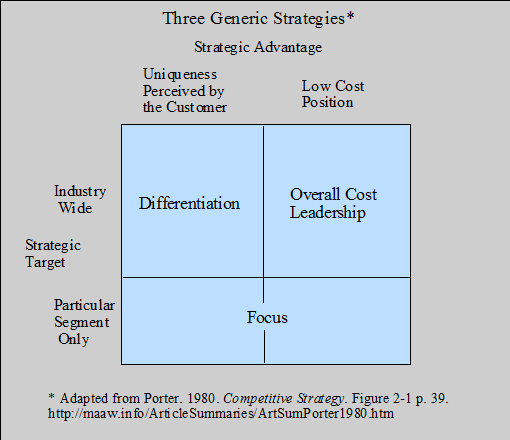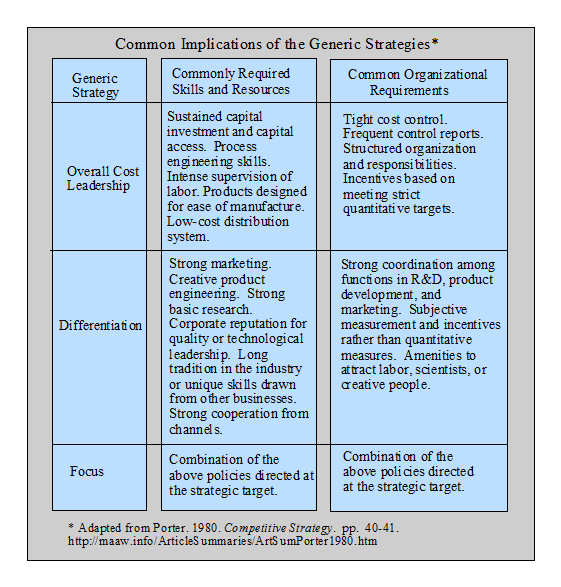
Chapter 2: Generic Competitive Strategies
Study Guide by James R. Martin, Ph.D., CMA
Professor Emeritus, University of South Florida
Porter's Competitive Strategy Summaries Main Page
Chapter 2: Generic Competitive Strategies p. 34
The purpose of this chapter is to describe three generic competitive strategies and some introductory concepts needed for subsequent analysis.
Three Generic Strategies p. 35
The three generic strategies include:
1. Overall cost leadership,
2. Differentiation, and
3. Focus
It is rarely possible for a firm to successfully pursue more than one of these strategies.
Overall Cost Leadership p. 35
A low cost position protects the firm against all five basic competitive forces described in Chapter 1. For example, buyers can only drive down prices to the level of the most efficient producer. The scale economies associated with a low cost position also provide a barrier to entry into the industry, and more flexibility in dealing with supplier cost increases. However, achieving cost leadership may require heavy capital investment and perhaps start-up losses to build market share, but once achieved cost leadership can provide high margins to support reinvestment to sustain the firm's low cost position.
Differentiation
A differentiation strategy can be achieved in various ways including differences in design or brand image, technology, features, customer service, dealer network, or other dimensions. Although differentiation does not allow a firm to ignore costs, it provides a defense against the five competitive forces through brand loyalty, the difficulty for competitors to overcome the firm's unique position, the lack of buyer alternatives, and the firm's enhanced ability to compete with substitute products. Customer's lower sensitivity to price may help the firm achieve higher margins and avoid the need for a cost leadership position. On the other hand, higher prices may prevent the firm from gaining a high market share. The high-end automobile market provides some good examples.
Focus
The focus strategy is based on serving a narrow specific target group better than competitors who serve the market as a whole. The strategy is to achieve a form of differentiation, or low cost in serving a particular market, or both differentiation and low cost. A focused position in an industry provides defenses to the five competitive forces similar to those discussed above, but there is a clear limitation to achieving a high market share in the industry.
The differences between the three generic strategies and some other implications of the strategies are provided in the two graphic illustrations below.


Stuck in the Middle p. 41
According to Porter, a firm that fails to compete using one of the three generic strategies is stuck in the middle, and almost guaranteed low profitability. In some cases stuck in the middle means that smaller focused or differentiated firms, and the largest cost leadership firms are the most profitable, while the middle-sized firms are the least profitable (See the U-shaped function below). However, the U-shaped function does not hold in all industries, and unless one redefines the industry as separate focused groups, there is no single relationship between profitability and market share.

Risks of the Generic Strategies p. 44
There are risks associated with the three generic strategies that are mainly related to changes in the competitive environment.
Risks of Overall Cost Leadership
Technological changes that eliminates the advantage of past investments or learning.
Newcomers or followers learn to produce to match the leader's low cost advantage.
Changes in the industry take place without the firm's awareness.
Cost inflation narrows the firm's ability to maintain a sufficient price differential.
Ford Motor Company of the 1920s provides the classic example of the risk of cost leadership.
Risks of Differentiation
Cost differences between the differentiated firm and the low cost leader become too great to hold brand loyalty.
Buyer's needs change and the differentiated product no longer provides a strategic advantage.
Imitation narrows the brand and strategic advantage of the differentiated product.
Risks of Focus
Cost differences become to great to maintain a focused strategy.
Differences between the strategy target and the general market products become to narrow to maintain a focus strategy.
Competitors out focus the focuser in submarkets.
__________________________________________________
Go to the next Chapter. Porter. 1980. Competitive Strategy. Chapter 3: A Framework for Competitor Analysis. (Summary), or back to Porter's Competitive Strategy Summaries Main Page.
The last section of this chapter reminded me of several summaries I developed on risk management. For example, see the Shenkir, and Walker summary on enterprise risk management below.
Other related summaries:
Christensen, C. M. 1997. Making strategy: Learning by doing. Harvard Business Review (November-December): 141-142, 144, 146, 148, 150-154, 156. (Summary).
Clinton, B. D. and A. H. Graves. 1999. Product value analysis: Strategic analysis over the entire product life cycle. Journal of Cost Management (May/June): 22-29. (Summary).
De Geus, A. 1999. The living company. Harvard Business Review (March-April): 51-59. (Summary).
Fonvielle, W. and L. P. Carr. 2001. Gaining strategic alignment: Making scorecards work. Management Accounting Quarterly (Fall): 4-14. (Summary).
Gadiesh, O. and J. L. Gilbert. 2001. Transforming corner-office strategy into frontline action. Harvard Business Review (May): 72-79. (Summary).
Gosselin, M. 1997. The effect of strategy and organizational structure on the adoption and implementation of activity-based costing. Accounting, Organizations and Society 22(2): 105-122. (Summary).
Iansiti, M. and R. Levien. 2004. Strategy as ecology. Harvard Business Review (March): 68-78. (Summary).
Johnson, M. W., C. M. Christensen and H. Kagermann. 2008. Reinventing your business model. Harvard Business Review (December): 50-59. (Summary).
Kaplan, R. S. and D. P. Norton. 1996. Using the balanced scorecard as a strategic management system. Harvard Business Review (January-February): 75-85. (Summary).
Kaplan, R. S. and D. P. Norton. 2000. Having trouble with your strategy? Then map it. Harvard Business Review (September-October): 167-176. (Summary).
Kaplan, R. S. and D. P. Norton. 2001. Transforming the balanced scorecard from performance measurement to strategic management: Part I. Accounting Horizons (March): 87-104. (Summary).
Kaplan, R. S. and D. P. Norton. 2001. Transforming the balanced scorecard from performance measurement to strategic management: Part II. Accounting Horizons (June): 147-160. (Summary).
Kaplan, R. S. and D. P. Norton. 2004. Measuring the strategic readiness of intangible assets. Harvard Business Review (February): 52-63. (Summary).
Kim, W. C. and R. Mauborgne. 1997. Value innovation: The strategic logic of high growth. Harvard Business Review (January-February): 103-112. (Summary).
Kim, W. C. and R. Mauborgne. 1999. Creating new market space: A systematic approach to value innovation can help companies break free from the competitive pack. Harvard Business Review (January-February): 83-93. (Summary).
Kim, W. C. and R. Mauborgne. 2002. Charting your company's future. Harvard Business Review (June): 77-83. (Summary).
Kim, W. C. and R. Mauborgne. 2004. Blue ocean strategy. Harvard Business Review (October): 76-84. (Summary).
Kim, W. C. and R. Mauborgne. 2009. How strategy shapes structure. Harvard Business Review (September): 72-80. (Summary).
Kim, W. C. and R. Mauborgne. 2015. Red ocean traps: The mental models that undermine market-creating strategies. Harvard Business Review (March): 68-73. (Summary).
Langfield-Smith, K. 1997. Management control systems and strategy: A critical review. Accounting, Organizations and Society 22(2): 207-232. (Summary).
Luehrman, T. A. 1998. Strategy as a portfolio of real options. Harvard Business Review (September-October): 89-99. (Summary).
Malone, D. and M. Mouritsen. 2014. Change management: Risk, transition, and strategy. Cost Management (May/June): 6-13. (Summary).
Martin, J. R. Not dated. What is a learning curve? Management And Accounting Web. LearningCurveSummary.htm
O'Clock, P. and K. Devine. 2003. The role of strategy and culture in the performance evaluation of international strategic business units. Management Accounting Quarterly (Winter): 18-26. (Summary).
O'Reilly, C. A. III. and M. L. Tushman. 2004. The ambidextrous organization. Harvard Business Review (April): 74-81. (Summary).
Porter, M. E. 1996. What is a strategy? Harvard Business Review (November-December): 61-78. (Summary).
Porter, M. E. 2001. Strategy and the internet. Harvard Business Review (March): 63-78. (Summary).
Reeves, M., C. Love and P. Tillmanns. 2012. Your strategy needs a strategy. Harvard Business Review (September): 76-83. (Note).
Shenkir, W. G. and P. L. Walker. 2006. Enterprise risk management and the strategy-risk-focused organization. Cost Management (May/June): 32-38. (Summary).
Simons, R. 1995. Control in an age of empowerment. Harvard Business Review (March-April): 80-88. (Summary).